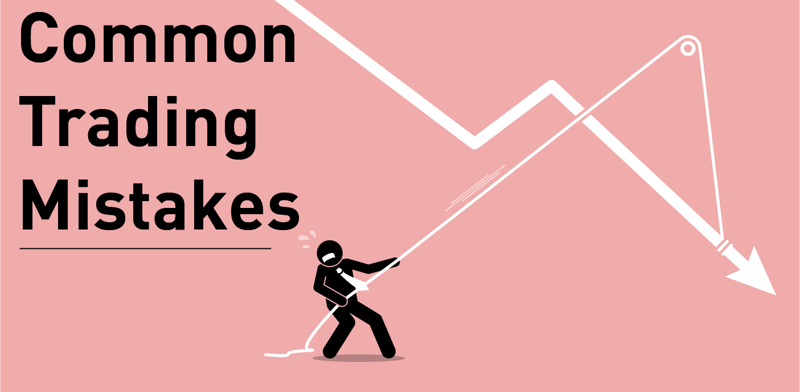Common Trading Mistakes
It’s a sad fact: Many traders fail because they fall prey to the same common trading mistakes.
Most day traders have a high failure rate. While it’s quite sobering, it doesn’t need to scare you off. Because, usually, traders don’t fail because trading is too difficult; they fail because they haven’t had the proper guidance, and often end up making predictable errors.
By learning these common trading mistakes, you can take proactive steps to help yourself avoid them.
1. Chasing hot stock tips. If you’re always a follower, you’ll never be a leader. Are you constantly seeking out stock tips from email blasts or advertisements? If so, then you’re doing yourself a great disservice as a trader.
And, you’re probably being played. After all, if a stock tip is really so smoking hot, why would it be advertised so publicly? Usually, this is just a scheme designed to inflate the price of a stock.
There’s a name for this: the pump and dump. It’s a common ploy where self-serving promoters try to get you to jump on a stock’s bandwagon.
You see, they’ve already bought in very low on the stock, and now they’re trying to drive up the price by getting others to invest. Then, when the price of the stock goes up, they sell, profiting while everyone else is left in the dust.
Download a PDF version of this post as PDF.
Don’t be fooled!
Rather than taking someone at their word about a hot stock tip, take the time to do your own research. Find out if the stock is a percentage gainer and has good volume, and research the company and potential catalysts that could be affecting its price.
By evaluating the company and the stock’s performance over time, you’ll get a better idea of whether it’s really a “hot” stock to buy.
2. Trying to force trades. On the surface, trading can seem very mathematical. But when it comes down to it, trading is just as much (if not more) of an emotional and mental game.
For example: Picture a new trader … he or she may enjoy a few “lucky” trades at first, earning a few profits … and they begin to have some unrealistic expectations … then, they experience some losses … and then things really start to snowball.
While losses are very normal (especially in early trading careers), many new traders begin to panic. This is typically when traders let their emotions take over and start making bad decisions.
In their desire to keep making profits, they begin to let things — like thorough research — fall by the wayside. Then many jump into ill-advised trades in hope of reviving their accounts.
Unfortunately, HOPE is a nasty four-letter word when it comes to trading.
If you simply roll the dice and hope for the best, prepare to experience the worst. Instead of letting your emotions get involved, strive to trade more like an emotionless robot.
What does that mean? Look at data and facts rather than relying on intuition. And know that sometimes, the best trade is no trade at all.
3. Believing that penny stock companies will succeed. It’s a beautiful idea, indeed, that you could buy a low-priced penny stock, watch the company become a superstar, and see the stock price go sky-high.
True, sometimes penny stocks make it. But more often than not, they fail. There’s a reason why these companies aren’t listed on the big national exchanges, after all. They usually don’t meet the necessary requirements to be traded on the NYSE or the DOW.
However, many traders fall into the trap of believing the hype. They truly believe they’re getting in early and will see this stock become the next Facebook. They buy, then they’re squeezed and their account is drained.
While it’s good to believe in the underdog, be a bit more jaded before you invest your hard-earned cash. Become an obsessive researcher and scanner of stocks, using tools like StocksToTrade.
Make your trades based on what the market tells you, rather than what you dream will happen.
4. Lack of education. Day trading has a reputation for being risky. The penny stock market is particularly volatile, and, as mentioned, the stocks are less regulated than stocks on the bigger national exchanges.
Many new investors jump into trades without understanding the risk involved or what makes the market so volatile — and they quickly begin losing money.
Yes, the stock market can be risky. But then again, so are many other professions, particularly if you’re not trained.
Think about it: If you’ve never used a hammer in your life, jumping into carpentry could be quite dangerous. However, if you’re properly trained in how to use the necessary tools, your risk level can go down considerably.
It’s similar with day trading. If you don’t understand how the market works, then every trade carries a high level of risk. However, once you take the time to learn the market’s mechanics and gain a fundamental knowledge base, you can make far more educated trading decisions.
This is the difference between taking calculated risks and being just plain risky. And it can make all the difference between failure and success!
The Bottom Line
When it comes down to it, most traders fail because of the same common trading mistakes. By identifying these mistakes and learning what they’re all about, you can better avoid them.
And when you combine this knowledge with a proper trading education, you’re making a powerful step toward establishing your goal of becoming one of the day traders who succeeds.
Are you guilty of any of these trading mistakes?
